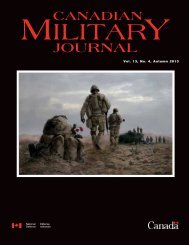MILITARY
JOURNAL CA - Revue militaire canadienne
JOURNAL CA - Revue militaire canadienne
- No tags were found...
You also want an ePaper? Increase the reach of your titles
YUMPU automatically turns print PDFs into web optimized ePapers that Google loves.
Reuters photo RTXLS73 by Chris Helgren<br />
German soldiers specializing in nuclear, biological, and chemical warfare detection and decontamination on exercise near Kuwait City, 2003.<br />
From Battlespace to Battlesphere<br />
by Peter H. Denton<br />
Introduction and Background<br />
The current reality of warfare has outstripped our<br />
ability to describe it. In using words/phrases like<br />
‘asymmetric’ or ‘fourth-generation’ warfare,<br />
referring to ‘the three-block war’ or ‘counterinsurgency<br />
operations’ (COINOPS), different<br />
efforts have been made to describe the changing nature of war<br />
in the 21 st Century. 1 Thanks to developments in technology,<br />
tactical objectives may now be more easily achieved on the<br />
battlefield, but they are also placed within a strategic mission<br />
opaquely intended to ‘win the hearts and minds’ of a civilian<br />
population entwined in the conflict.<br />
Given space-based weapons systems, cyber-warfare, biological<br />
warfare, electronic warfare, economic warfare, and<br />
whatever else inventive minds can create to harm their antagonists,<br />
‘battlefield’ as a concept evokes archaic images of<br />
British ‘redcoats’ forming square to repel cavalry. There has<br />
been a growing consensus that the appropriate term should<br />
instead be ‘battlespace.’ 2 While there are some advantages to<br />
the battlespace concept (and I have used it myself), 3 it is ultimately<br />
inadequate to describe 21 st Century warfare, and this is<br />
for two main reasons. First, battlespace as a concept is dimensionally<br />
inadequate. It has no necessary or identifiable boundaries.<br />
In its weak form, it is merely an arbitrary extension of<br />
the battlefield concept to incorporate more (but not all) of the<br />
additional elements believed to affect some particular engagement.<br />
In its strong form, it requires us to consider all aspects<br />
of society and culture in terms of their potential involvement<br />
in the conduct of 21 st Century warfare.<br />
To consider the weak form of the concept, extending the<br />
battlefield into a larger battlespace does have some merit, as it<br />
involves air, sea, electronic, and space assets able to affect (in<br />
some fashion) specific combat operations. It means, at least in<br />
theory, that the commander can weave all these things together<br />
to create a local tactical advantage, including whatever is<br />
known about the civilian population in an area. There are,<br />
however, a wide variety of factors outside a commander’s control<br />
that can have a material effect, not only on the conduct of<br />
any specific engagement, but also on its aftermath.<br />
Cyber-warfare is often cited as one example – what might<br />
happen if a delivery guidance system could be hijacked by the<br />
enemy, or if GPS navigation could be skewed or shut down –<br />
but there are many far less dramatic ways to disrupt technologically<br />
complex and therefore fragile combat systems.<br />
Peter Denton, PhD, is an Associate Professor of History at the Royal<br />
Military College of Canada. He is a regular contributor to the Canadian<br />
Military Journal.<br />
26 Canadian Military Journal • Vol. 12, No. 4, Autumn 2012





